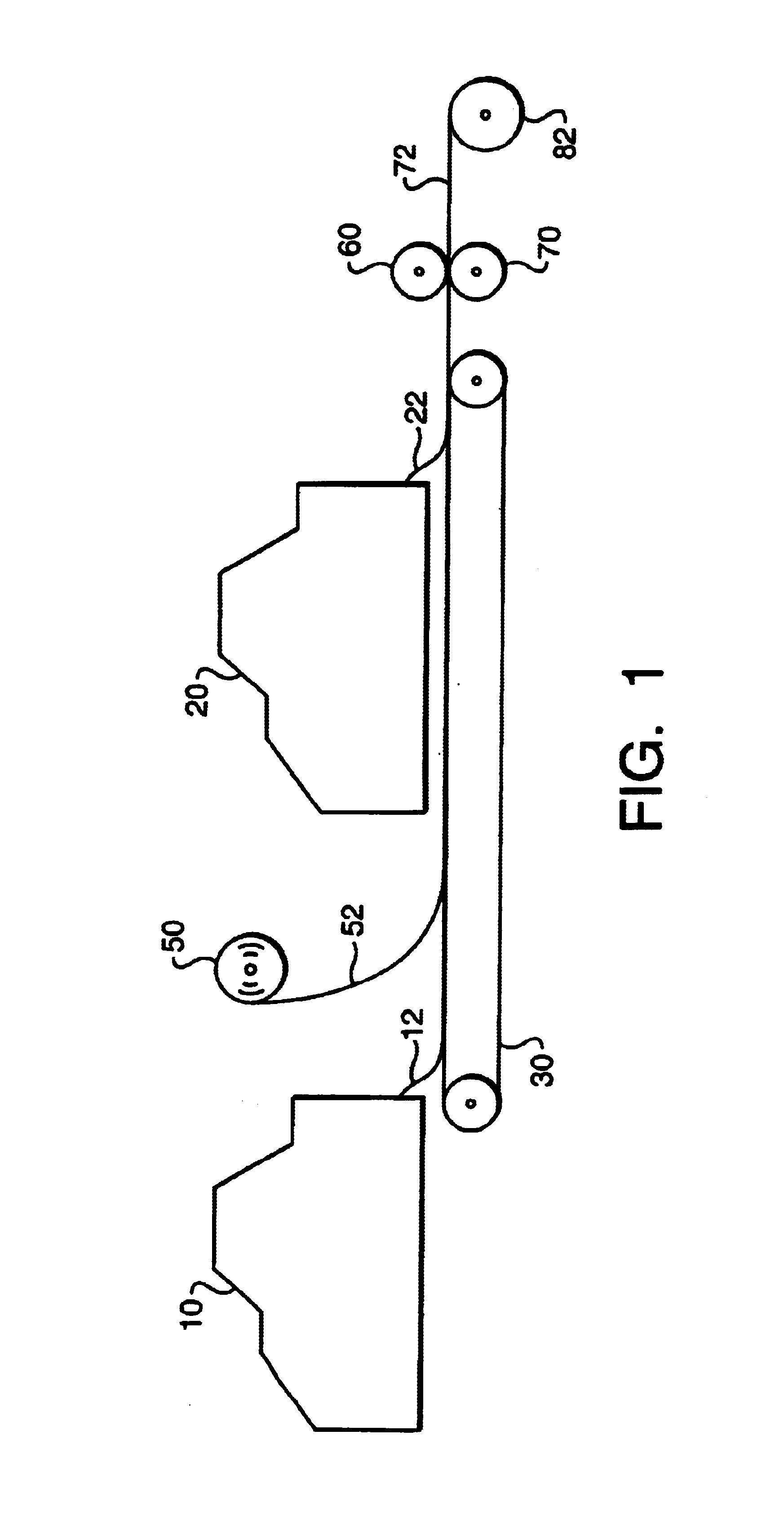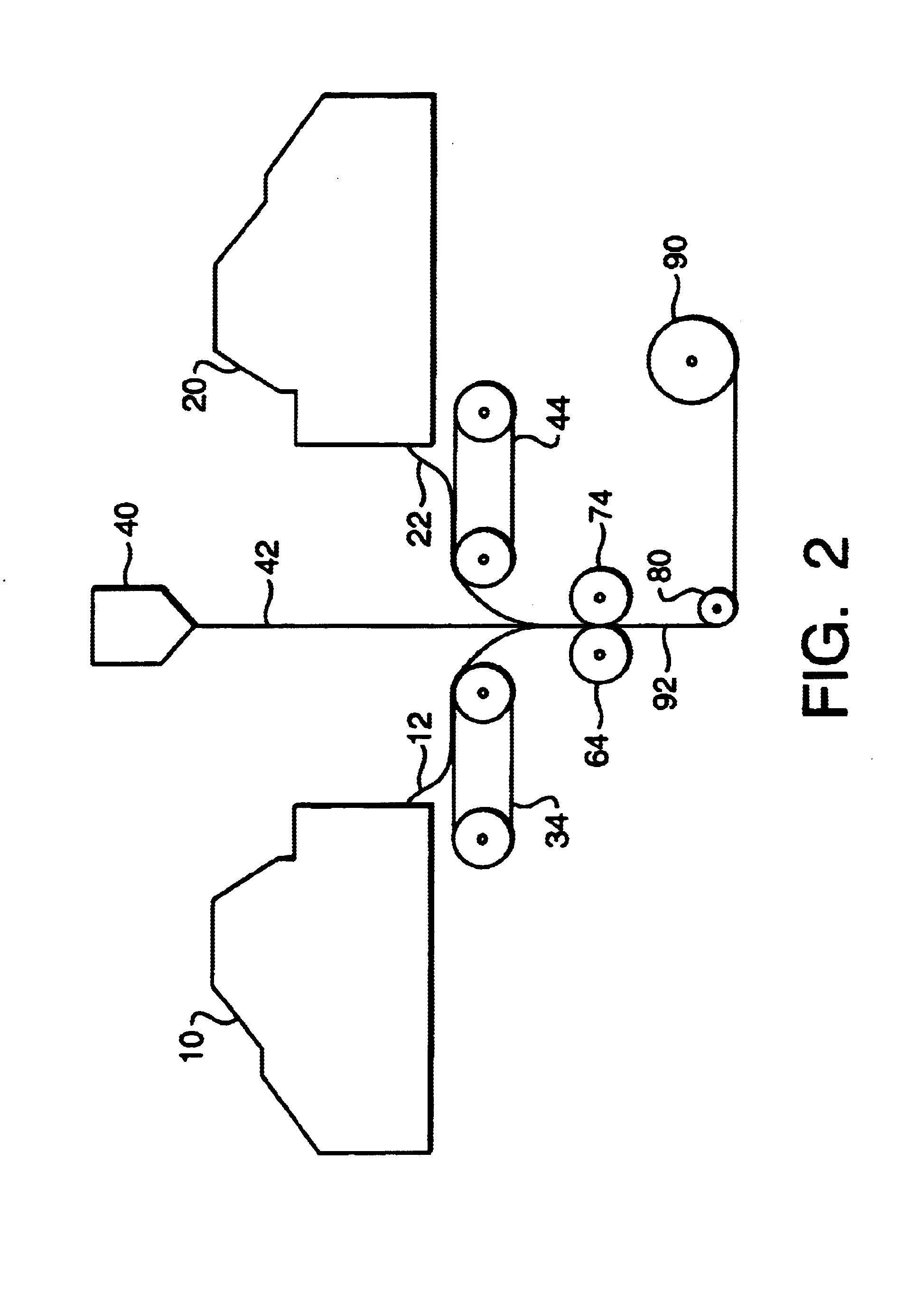Low-cost elastic laminate material
- Summary
- Abstract
- Description
- Claims
- Application Information
AI Technical Summary
Benefits of technology
Problems solved by technology
Method used
Image
Examples
example 1
[0061]Non-bonded staple fiber webs comprising 100% polypropylene staple fibers were produced on two Hollingsworth carding machines available from John D. Hollingsworth On Wheels of Greenville, S.C. Each non-bonded staple fiber web had a basis weight of 24 gsm. The polyproplylene fibers were 2.2 denier, 1.5 inch (38 mm) fibers available from Fiber Visions of Covington, Ga. and designated T-196 PP fiber. A single-layer elastic film was cast onto a chill roller and thereafter directed between the two non-bonded staple fiber webs. The film was a 40 gsm ethylene-octene copolymer plastomer film available from Dow Chemical Company of Midland, Mich. under the trade name AFFINITY EG 8200. The two non-bonded staple fiber webs were then thermally bonded to either side of the elastic film using thermal pattern bonding, with the calender having a wire weave pattern. The bonding temperature was set at 280° F. (138° C.). After being elongated to 150 percent of its original unstretched CD dimension...
example 2
[0062]Non-bonded staple fiber webs comprising 100% polypropylene / polyethylene bicomponent eccentric sheath-core staple fibers were produced on two Hollingsworth carding machines available from John D. Hollingsworth On Wheels of Greenville, S.C. Each non-bonded staple fiber web had a basis weight of 24 gsm. The polypropylene fibers were 1.5 denier, 1.5 inch (38 mm) fibers available from ES FiberVisions of Athens, Ga. and designated ESC-215 fiber. A single-layer elastic film was cast onto a chill roller and thereafter directed between the two non-bonded staple fiber webs. The film was a 40 gsm ethylene-octene copolymer plastomer film available from Dow Chemical Company of Midland, Mich. under the trade name AFFINITY EG 8200. The two non-bonded staple fiber webs were then thermally bonded to either side of the elastic film using thermal pattern bonding, with the calender having a wire weave pattern. The bonding temperature was set at 280° F. (138° C.). After being elongated to 150 perc...
example 3
[0063]Non-bonded staple fiber webs and elastic film were produced as in Example 1 with the exception that the non-bonded staple fiber webs each had a basis weight of 12 gsm. The non-bonded staple fiber webs and elastic film were bonded into a laminate using the wire weave patterned calender as in Example 1. After being elongated to 150 percent of its original unstretched CD dimension, a sample of the elastic laminate material of Example 3 recovered 84 percent of that elongation upon release of the stretching force.
PUM
| Property | Measurement | Unit |
|---|---|---|
| Percent by mass | aaaaa | aaaaa |
| Percent by mass | aaaaa | aaaaa |
| Percent by mass | aaaaa | aaaaa |
Abstract
Description
Claims
Application Information
 Login to View More
Login to View More - R&D
- Intellectual Property
- Life Sciences
- Materials
- Tech Scout
- Unparalleled Data Quality
- Higher Quality Content
- 60% Fewer Hallucinations
Browse by: Latest US Patents, China's latest patents, Technical Efficacy Thesaurus, Application Domain, Technology Topic, Popular Technical Reports.
© 2025 PatSnap. All rights reserved.Legal|Privacy policy|Modern Slavery Act Transparency Statement|Sitemap|About US| Contact US: help@patsnap.com



